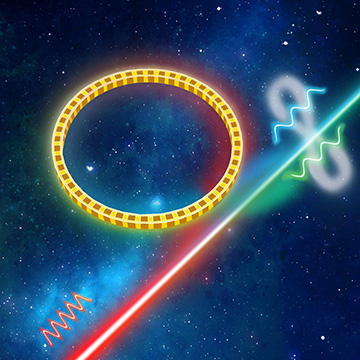
Artist view of a ring resonator, converting a single input photon into two down-converted entangled output photons. [Image: QuEST Lab / Stevens Institute of Technology]
The ability to generate pairs of entangled photons is key to many quantum information technologies under development. But doing so at the high rates and efficiencies needed for practical applications has so far proved a challenge.
Now, researchers in the United States have built a lithium-niobate microresonator on a chip and shown that it can produce photon pairs more than 100 times more efficiently than other chip-based photon sources (Phys. Rev. Lett., doi: 10.1103/PhysRevLett.125.263602). By integrating it with other optical components, they reckon the tiny resonator could help enable the “pervasive adoption” of quantum devices.
Micron-thin SPDC engine
The microresonator, made on a micron-thin layer of crystal, generates photon pairs via the nonlinear process of spontaneous parametric down-conversion (SPDC). An intense laser beam directed at the device leads photons to be confined within the structure, where some of them split into pairs of photons at lower energies.
Lithium niobate, an artificial salt, is one of the most widely used crystals for such research, as it exhibits significant optical nonlinearities; it’s also transparent across a range of frequencies and generates strong electro-optic effects. As a result, the material is already employed in numerous optical and electronic devices.
But integrated lithium niobate, in the form of a thin film on top of an insulator, has not yet enabled fully practical quantum devices. That’s because such devices must satisfy a number of quite strict conditions before they can function as bright, pure sources of quantum particles. Not only must they exhibit strong nonlinearities and tightly confine light over extended periods; they also must ensure phase matching between the incoming and outgoing light waves.
Balancing act
In the latest work, Yuping Huang and colleagues at the Stevens Institute of Technology, NJ, USA, say they have managed to pull off this tricky balancing act by using an arrangement known as periodic polling. They bonded a 700-nm-thick film of lithium niobate onto a layer of silicon dioxide and alternated the material’s optical orientation in a series of bands each just under 4 μm wide. Using electron beam lithography and ion milling, they then carved out a 110-μm-diameter microring such that the light waves interact inside over extended periods of time.
Huang and co-workers exposed the device to visible light from a continuous-wave laser and used superconducting single-photon detectors to register the infrared photon pairs coupled out of the microring. They found they could generate nearly 3 million photon pairs a second for every microwatt of incident laser power. That was within a factor of three of the theoretical prediction—and at least 100 times greater than the previous best (also obtained with lithium niobate).
Toward quantum devices
Adding to this, the researchers found that their photon pairs came with low levels of background noise and were generated over multiple wavelength channels—which, they say, lends them to applications such as high-dimensional entanglement and optical quantum computing. (The photons in the experiment were entangled, but that entanglement was not measured.) The team also showed that it could produce so-called heralded single photons with high fidelity and low noise.
What’s more, the researchers say that their device can be readily integrated with other components, such as electro-optical modulators and frequency converters, on the same chip. Doing so, they claim, would allow “high-speed, reconfigurable and multifaceted functional quantum devices” to be realized.
They add, however, that real-world applications will require even higher efficiencies than those the team has attained. Ideally, according to Huang, they would like to get to the point where each and every incoming photon yields a photon pair. To that end, he and his colleagues are further improving the resonator’s quality factor by making the cavity walls smoother. “This is the last piece of the puzzle for us to solve,” he says.
